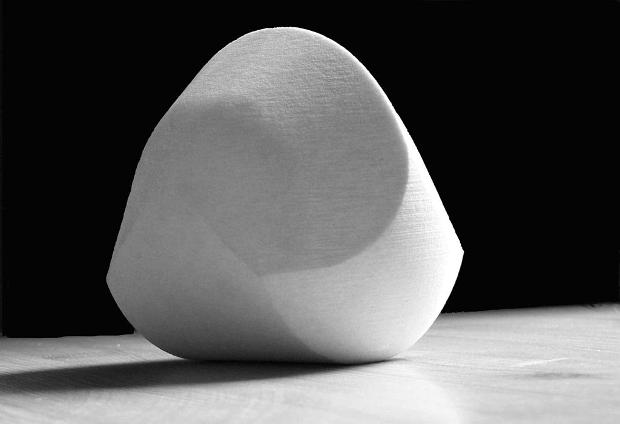A gömböc is a mythological beast with the head of a blue whale, the body of a miniature horse, and the temperament of a honey-badger. No, not really…
It’s actually a solid homogeneous object that has only one stable equilibrium. In layman’s terms, this means that when you place a gömböc on a table, it will roll around about until it settles down, and there is only one possible position it can settle down to.
I hear you say “So what? This isn’t unusual at all!” Well, it actually is. First of all the word “homogeneous” is key: this means that the object has the same density at all points. So things like lawn bowls, which are weighted on one side, don’t count as gömböcs. Neither do those inflatable clowns you can punch in the face but keep popping back up for more. The idea of a gömböc is that the shape alone causes it to have one equilibrium, not the distribution of mass inside.
Thought experiments
Imagine a sphere of constant density (so that no part is heavier than any other part). It has an infinite number of equilibrium points: it can stay balanced on any orientation. It won’t roll around on a table of its own accord (you have to push it, or the table has to be on an angle)
Also imagine a “perfect” egg (i.e. constant density: which is highly unrealistic of course). If you balance it on its tip, it will fall over, roll around a bit, then settle down. But there are still an infinite number of orientations it can settle down in. Try it yourself: draw a pattern on it so you can tell if it’s settling down at different points or not.
The idea that a gömböc might actually exist was proposed by a mathematician called Vladimir Arnold in 1995. It wasn’t until 11 years later that it was actually proved to exist. There are many different gömböcs, but they are all incredibly finely-tuned: a slight flaw in their shape breaks their gömböc-ness and it will gain extra equilibrium points.
So what does a gömböc look like?

To see one in action, check out this video. You can see it actually takes a bit of time for it to settle down, but the key point is that no matter how you start it off, it will always stabilise in exactly the same orientation.
Stranded tortoises
Now everyone loves tortoises, but it may not be immediately apparent why there is a picture of one at the top. Well, there is evidence to suggest that some tortoise shells are a bit gömböc-y in their shape. This provides a massive advantage for tortoises when they unfortunately find themselves upside down. The natural gömböc shape would tend to roll them back the right way up! Of course tortoises rarely find themselves upside down on perfectly flat tables, so in reality it requires a bit of neck and leg waving to get moving.
Sometimes though you just need a bit of help from a friend.
The image of the tortoise above is borrowed and edited, with thanks, from S. Rossi under a Creative Commons Licence.
Thank you very much for that interesting err blog? Another fact I can wow friends with after many drinks…I thoroughly enjoy their baffled looks which is very wicked of me, but fun.